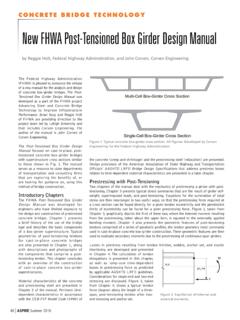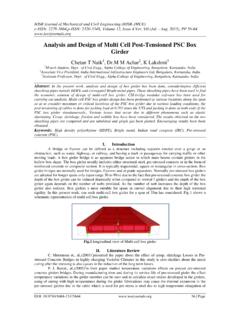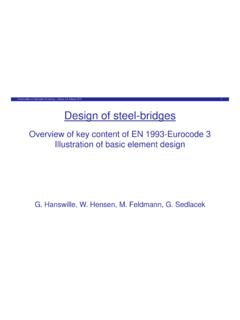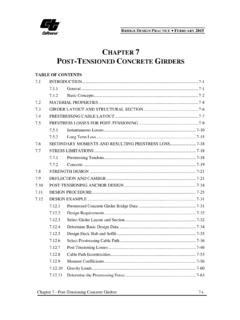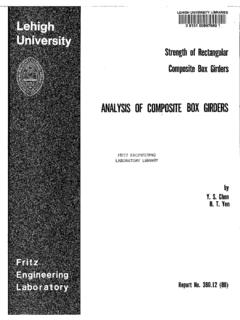Transcription of SEGMENTAL Box GIRDER: DEFLECTION PROBABILITY AND …
1 SEGMENTAL Box GIRDER: DEFLECTION If creep and shrinkage properties of concrete are predicted solely on the PROBABILITY AND BAYESIAN UPDATING basis of the existing models, the uncertainty is very large. For the BP model (Bazant and Panula 1978, 1980, 1982), errors that are exceeded with a 5%. By Zdenek P. Baiant/ Fellow, ASCE, and Joong-Koo Kim2 PROBABILITY ( on the plus side, on the minus side) are about 37%, while for the simpler but less realistic models of ACI Committee 209/11. ABSTRACT: Probabilistic prediction of the confidence limits on long-time deflec- (1971, 1982) and CEB-FIP (1978) they are 75% and 91%, respectively (BaZant tions and internal forces of prestressed concrete SEGMENTAL box-girder bridges is and Panula 1982; BaZant 1988; Zebich and BaZant 1981).
2 As shown in BaZant developed. The uncertainty of the predictions based on the existing models for concrete creep (the prior) is very large, but it can be greatly reduced by Bayesian and Panula (1982), this uncertainty can be greatly reduced if some short- updating on the basis of short-time measurements of the deflections during con- time measurements are made and Bayesian statistical reasoning applied. An struction or of short-time creep and shrinkage strains of specimens made from the analytical method to do that for long-time creep compliance of concrete was same concrete as the bridge .
3 The updated (posterior) probabilities can be obtained by latin hypercube sampling, which reduces the problem to a series of deterministic developed in Bazant (1983) and Bazant and Chern (1984). This method, creep structural analyses for randomly generated samples of random parameters of however, works only if the creep law is linearized and if there are only few the creep and shrinkage prediction model. The method does not require lineariza- random parameters (two or three). None of these simplifications is adequate tion of the problem with regard to the random parameters, and a large number of for predicting deflections of an entire box girder.
4 The random parameters can be taken into account. Application to a typical box- girder bridge with age differences between its segments and with a change of struc- General applicability can be achieved by combining Bayesian updating tural system from statically indeterminate to determinate is illustrated numerically. with a sampling approach, as formulated in Bazant (1985). This reduces the The results prove that design for extreme, rather than mean, long-time deflections problem to a series of conventional (deterministic) structural creep analyses and internal forces is feasible.
5 Adoption of such a design approach would improve for various samples of random parameters. A novel sampling method, called long-term serviceability of box-girder bridges. latin hypercube sampling (McKay 1980; McKay et a1. 1979, 1976), has been adopted. This sampling method, which was originally applied to direct (non- INTRODUCTION Bayesian) probabilistic prediction of structural creep effects (Bazant and Liu 1985), and was later extended to Bayesian extrapolation of shrinkage data Prestressed concrete SEGMENTAL box-girder bridges are structures that are (Bazant et a1.)
6 1987), is computationally much more efficient than the method particularly sensitive to their long-time deformations. Deflections much in of point estimates used previously (Madsen and Bazant 1983). excess of their calculated values or severe cracking after a longer service In the present study, Bazant's (1985) method used for shrinkage in Bazant period have often been experienced. The consequences, which include costly et a1. (1987) will be applied to short-time measurements during construction repairs and even closing of a bridge before the end of its design lifetime, in order to improve the predictions of long-time deflections and internal forces represent a great economic loss.
7 One important cause of this situation is no in a SEGMENTAL box girder which undergoes a change of its structural system doubt the fact that, outside the laboratory, creep and shrinkage of concrete during construction and has a nonuniform age of concrete. This approach are highly uncertain random phenomena, influenced by many random pa- has the potential of substantially reducing the uncertainty of long-time pre- dictions and making it possible to adjust the vertical alignment of the seg- rameters. Predicting only mean deflections, which is the current practice, is ments during construction, thereby minimizing deviations from the desired insufficient.
8 The design should be based on predictions of extreme deflec- vertical profile of the bridge . tions that are exceeded with a certain specified small PROBABILITY . The probabilistic approach necessitates a realistic creep prediction model, such as the BP model (Bazant and Panula 1978,1980, 1982). In probabilistic LINEAR CREEP ANALYSIS OF SEGMENTAL Box GIRDER. analysis, it would make little sense to use simple but unrealistic models that Concrete is assumed to behave as an aging linearly viscoelastic material have large systematic errors resulting from inadequacy of the mathematical (Bazant 1982a, 1988).
9 It is characterized by the compliance function J(t, t'). model per se, rather than from randomness of influencing parameters. On representing the strain of concrete at time t caused by a unit uniaxial stress the other hand, the usefulness of a sophisticated creep prediction model, such applied at time t'. J(t, t') is defined, according to the BP model (Bazant and as the BP model, is limited unless its use is combined with a probabilistic Panula 1978, 1980, 1982), as a sum of the asymptotic elastic compliance, approach.
10 The basic creep compliance, and the drying creep compliance. The shrinkage 'Prof. ofCiv. Engrg., Dept. ofCiv. Engrg., The Tech. Inst., Northwestern Univ., strain, also defined according to the BP model, is assumed to occur ho- Evanston, IL 60208. mogeneously throughout the cross section, which is a usual simplification 2 Grad. Res. Asst., Dept. of Civ. Engrg., The Tech. Inst., Northwestern Univ., in design . The thermal strains are ignored. Evanston, IL. Note. Discussion open until March I, 1990. To extend the closing date one mon~h, In a typical SEGMENTAL bridge (Fig.)

